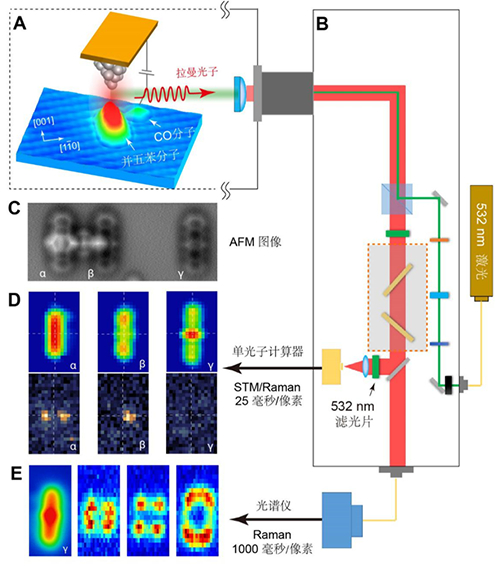With the support of the National Natural Science Foundation of China (Grant number: 21972129), the research group of Profs. Jianguo Hou, Bing Wang and Shijing Tan from the University of Science and Technology of China (USTC) developed a joint strategy to combine scanning tunneling microscopy, atomic force microscopy and tip-enhanced Raman spectroscopy, enabling a comprehensive characterization of various intrinsic parameters to achieve univocal determination of the heterogeneities of single molecules. The research work was published in Science on February 19, 2021, entitled "Determining structural and chemical heterogeneities of surface species at the single-bond limit" (2021, 371: 818–822; DOI: http://science.sciencemag.org/content/371/6531/818).
Identifying the structural and chemical heterogeneities of surface species has been the key to surface science. The heterogeneities of surface species originate from various intrinsic properties, such as molecular structures, electronic states, chemical bond vibrations etc. The precise and comprehensive measurements of these multi-dimensional properties have been a challenge at cutting-edges for decades. To this end, different kinds of microscopies with the measurements of electron, force and photon has been developed in the past decades. Specifically, the invention of scanning tunneling microscopy (STM) and noncontact atomic force microscopy (AFM) have enabled the Ångström-level measurements of electronic and geometric structures of single molecules in real space. However, both techniques are lack of chemical sensitivity. In 2013, the research group at USTC developed the tip-enhanced Raman scattering (TERS) technique, which achieved real-space chemical recognition with sub-nanometer resolution (Nature, 2013, 498: 82). Last year, they further advanced the TERS resolution to 1.5 Ångström (National Science Review, 2019, 6: 1169).
Based on these previous studies, the research group recently developed a joint STM-AFM-TERS strategy (Figure 1), which overcomes the limitation of each individual technique and provides a comprehensive characterization of multipleproperties. The capability of this joint strategy was demonstrated by using pentacene molecule and its derivatives on Ag(110) surface as model systems, where the heterogeneities are determined from selective C-H bond breaking. Technically, to track the chemical transformations of pentacene molecule, a high-speed single-photon avalanche photodiode was used to record the Raman photon signal, which increased the Raman imaging speed by two orders of magnitude than the previous TERS technique with spectrometer. In combination with theoretical calculations, the selective C-H bond breaking was attributed to specific plasmonic excitation, and the heterogeneities obtained from STM-AFM-TERS measurements were well simulated.
This joint STM-AFM-TERS strategy can provide a solution for univocally determining the chemical structures that are widely presented in surface catalysis, on-surface synthesis and 2D materials, which is of great scientific value for surface chemistry and heterogeneous catalysis.

Figure 1: (A) The schematic of joint STM-AFM-TERS strategy. (B) the optical setup for TRES measurements. (C) constant height AFM images. (D)simultaneously recorded STM topography and APD photon map of the C-H stretching mode of pentacene species.(E)Raman maps of the characteristic vibrations in the molecular skeleton of pentacene.

Add: 83 Shuangqing Rd., Haidian District, Beijing, China
Postcode: 100085
Tel: 86-10-62327001
Fax: 86-10-62327004
E-mail: bic@donnasnhdiary.org
京ICP备05002826号 文保网安备1101080035号 Copyright 2017 NSFC, All Right Reserved